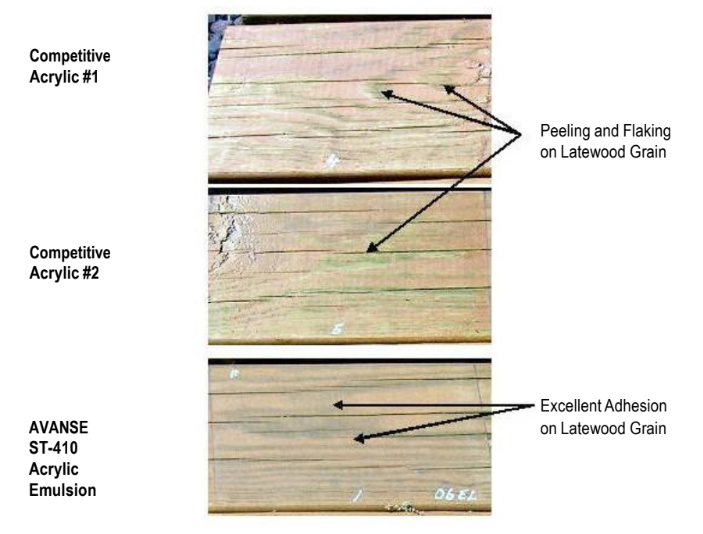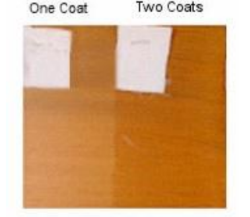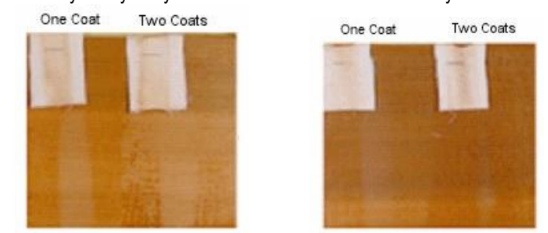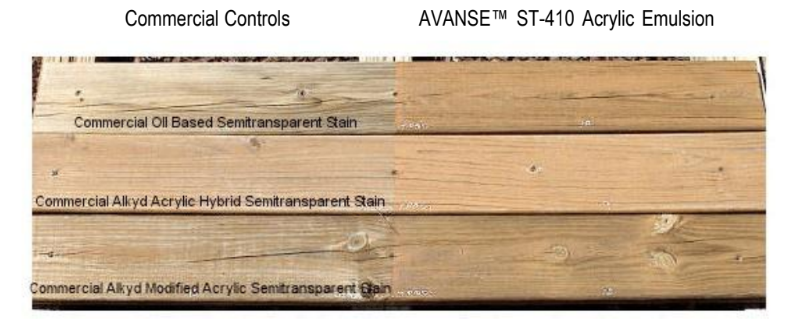Enhanced TDS
Identification & Functionality
- Blend
- No
- CASE Ingredients Functions
- Chemical Family
- Country of Origin
- Function
- Binder
- Product Code
- MITM11280
- Single Ingredient
- Yes
- Technologies
- Product Families
Features & Benefits
- CASE Ingredients Features
- Labeling Claims
- Product Performance
Application Properties
- AVANSE™ ST-410 Acrylic Emulsion is a 100% acrylic emulsion developed specifically for low VOC exterior semitransparent wood stains.
- The unique polymer stabilization in AVANSE™ ST-410 Acrylic Emulsion helps to extend the workability of this polymer as it dries, giving good flow and lapping on porous surfaces.
- Adhesion to Metal Based CCA Replacement Wood Preservatives
- The unique interaction of the AVANSE™ ST-410 Acrylic Emulsion with metals also gives excellent adhesion on new wood treated with copper metal based wood preservatives.
Adhesion to Copper Azole Treated Pine
Exposed 6 Months at Horizontal Up
AVANSE™ ST-410 Acrylic Emulsion
AVANSE™ ST-410 Acrylic Emulsion has better adhesion to copper based wood preservatives than competitive acrylic stain binders.
Early Water Resistance and Hardness Development- Stains based on AVANSE™ ST-410 Acrylic Emulsion have very good early water resistance and hardness development on decking substrates.
- Especially on high tannin woods like cedar or redwood, the early water resistance and hardness is much better than water dispersible alkyds or alkyd acrylic hybrids.
- Tannins from these woods can slow the oxidative cure of these systems, giving a tacky, water sensitive film after an overnight dry.
Early Wet Abrasion Resistance on Cedar
16 Hours Dry, 16 Hours Exposure in Fog Box

AVANSE™ ST-410 Acrylic Emulsion Alkyd Acrylic Hybrid Water based Solvent Alkyd
AVANSE™ ST-410 Acrylic Emulsion has excellent wet abrasion resistance in one or two coats after an overnight dry. It is better than an alkyd/acrylic semitransparent stain and a solvent based semitransparent stain on cedar.
Exterior Durability
- The 100% acrylic backbone in AVANSE™ ST-410 Acrylic Emulsion gives excellent exterior durability.
- Properly formulated AVANSE™ ST-410 Acrylic Emulsion stains protect the wood and provide a long service life.
- Exposure studies have shown that stains based on AVANSE™ ST-410 Acrylic Emulsion have exterior durability equal to or better than commercial solvent or water based semitransparent stains.
- The picture below shows the excellent fade resistance and adhesion of the AVANSE™ ST-410 Acrylic Emulsion compared to commercial semitransparent stains.
30 Month Exterior Durability
Exposed Horizontal Up on ACQ Treated Pine
AVANSE™ ST-410 Acrylic Emulsion has better fade resistance, adhesion and erosion resistance than the commercial semitransparent stains.
- Key Features
- Excellent initial appearance–crisp colors that bring out the natural warmth of the wood
- Outstanding adhesion
- Superior color retention
- Durable longer lasting coating
Environmentally Advanced
- Replaces traditional solvent based technologies
- Does not require coalescent
- No heavy metal driers
- APEO free
Unique particle stabilization
- Excellent flow and wetting
- Very good lapping
- Rapid hardness development – even over high tannin woods
- Excellent early water resistance
Applications & Uses
- Coating End Applications
- Compatible Substrates & Surfaces
- Markets
- Applications
Properties
- Physical Form
Packaging & Availability
- Packaging Type
Principal Information
- Group Principal Number
- S000005
- Principal
Storage & Handling
- Storage Conditions
Store products in tightly closed original containers at temperatures recommended on the product label.
- Handling Information
- Keep combustible and/or flammable products and their vapors away from heat,sparks, flames and other sources of ignition including static discharge.
- Processing or operating at temperatures near or above product flashpoint may pose a fire hazard.
- Use appropriate grounding and bonding techniques to manage static discharge hazards.
- Failure to maintain proper volume level when using immersion heaters can expose tank and solution to excessive heat resulting in a possible combustion hazard, particularly when plastic tanks are used.
Other
- Appearance
- Milky white liquid
- Color (SDS)
- White
- Item Number
- Odor (SDS)
- Ammonia
- Other Hazards
- No data available
- Protect from Freezing
- Yes
- Temperature Control
- Yes
- USA/DOT UN Number
- Not Applicable
- Chemical Properties
Value Units Test Method / Conditions pH 8.5-9.5 - - Material Composition
Value Units Test Method / Conditions Solid Content 37.0 % % - Physical Properties
Value Units Test Method / Conditions Density 8.69 lb/gal lb/gal Density 9.34 lb/gal lb/gal Dry Solids Basis Film Forming Temperature max. 3.0 °C °C Storage Temperature 34.0-120.0 °F °F Viscosity max. 1000.0 cPs cPs Brookfield Viscometer 60 rpm, #2 spindle - SDS Physical and Chemical Properties
Value Units Test Method / Conditions Boiling Point (SDS) 100.0 °C °C Water Evaporation Rate (SDS) max. 1.0 % % Butyl acetate = 1, water Melting Point (SDS) 0.0 °C °C Water Relative Density (SDS) 1.0-1.2 - Water = 1 Relative Vapor Density (SDS) max. 1.0 - Vapor Pressure (SDS) 17.0 mm Hg mm Hg at 20°C, Water Viscosity (SDS) 100.0-1000.0 mPa.s mPa.s Volatile Content (SDS) 62.0-65.0 % % pH (SDS) 8.5-9.5 - - Shelf Life & Stability
Value Units Test Method / Conditions Shelf Life 540.0 d d
